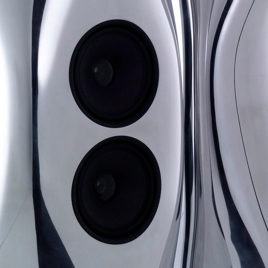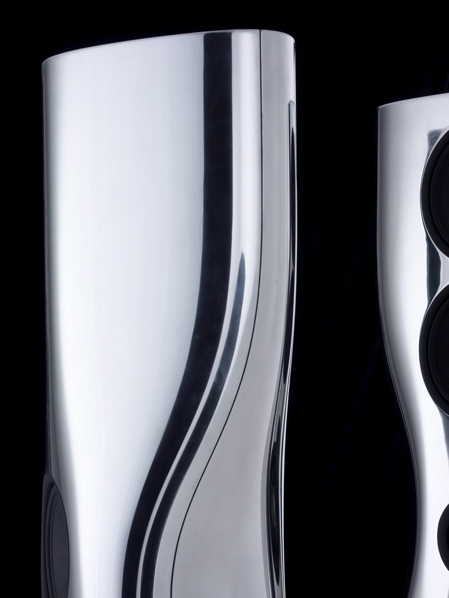
Ross Lovegrove for KEF
Milan preview: Ross Lovegrove has designed a two-metre tall speaker system for UK audio brand KEF, which will be launched in Milan this April.

Called Muon, the speaker cases are made from super-formed aluminium.
Details of the Milan show location and opening times, plus the (fairly purple) press release follow...
--
KEF and Ross Lovegrove present an exhibition during ‘FUORI’ Salone del Mobile di Milano Wednesday 18th - Monday 23rd April 2007
Address:
Leonardo da Vinci, National Museum of Science and Technology, Sala del Cenacolo – second cloister, Via San Vittore 21 Milano (Area Magenta)
Opening Times:
April 19th – 23rd
12.00 noon 9:00 pm
Launch Party:
18th April
6:30 – 10:30 pm
By invitation only.
--
In one of the most fascinating locations in Milan, MUON will be presented at the Sala del Cenacolo. This exhibition is the extraordinary result of the convergence of two masters.
The Loudspeakers, which are two metres tall, are remarkable reflective sound sculptures created by the advanced research centre of KEF, the British-based world leader in sound technology and Ross Lovegrove, considered one of the most innovative designers of the 21st century.
There can be few design-led manufacturing projects in this world where the central aim is to create an ‘ultimate’. But this was precisely the goal at KEF when the company’s owner commissioned the visionary industrial designer, Ross Lovegrove, to develop with them Muon – perhaps the most extraordinary audio speaker ever conceived.
The aim with the creation of Muon was to marry a sensual yet logical organic form to state-of-the-art audio technology. Appointing Ross Lovegrove as the designer to help them achieve this aim was indeed a wise move.
Lovegrove is a visionary, materials-led, industrial designer. His career has been galvanised by the form-inspiring and poetic qualities of materials and manufacturing processes – what is unique about his work, is his holistic approach to design – his aim is always to create objects in which functional and ergonomic refinement are united with deep emotional magnetism.
The result of this collaboration is a speaker which holds a seductive, curvaceous form, inspired by the abstract sculptures of Barbara Hepworth and Henry Moore, yet boasting a technology- driven acoustic design that has managed to establish a major benchmark in clarity.
As KEF’s senior Acoustic Engineer, Andrew Watson states ‘we wanted to take our technology to the limit and then develop some more on the way.’ The upshot is an unparalleled loudspeaker that will bring to serious audiophiles as well as music lover’s sound quality that defies belief - a product that is spectacular and which is able to imbue the perfect synthesis of art and science.
The technology and design behind Muon
Design: The Muon loudspeaker is fabricated from super-formed aluminium which is a similar moulding process to vacuum forming. This concept uses malleable sheets of heated aluminium to achieve otherwise impossible shapes. The eventual form of the loudspeaker was the result of a careful ‘conversation’ between Ross Lovegrove’s design aesthetics and the physics of sound. The process by which they were conceived meant that, in effect, Ross Lovegrove was sculpting the sound by ‘skinning’ the technology with purposeful form – the final shape was created through an evolutionary process that ensured ‘it could only be the form that it is.’
A UK based company that has strong links with the aeronautics and automotive industries milled a prototype from an enormous billet of solid aluminium. Using state-of-the–art computer-aided manufacture software the machine precisely cut away the excess material from the six foot long block of solid metal to reveal the final form – in total the milling took about a week.
Technology: Muon’s four-way speaker system mounted into the front of the structure with its powerful bass drivers is one of the things that make it so special. But it is also the upper mid-range and treble where some of the Muon’s key technology lies in the form of the UniQ drive unit array, remarkable in its construction and delivering a seamless sonic picture throughout the listening environment.
KEF has also used its Acoustic Compliance Enhancement technology, which enables them to effectively double the available volume through adsorption of air molecules on activated carbon, or ‘magic dust’. The two additional bass drivers mounted in the back of Muon help to produce a remarkably clean and open sound. Finally the 6mm thick, heavily damped aluminium shell provides a totally rigid structure that minimises any sound distorting vibrations.
Conclusion
The name Muon is inspired by physics – a ‘muon’ is an elementary particle with a negative electric charge, by mythology – ‘Mu’, is a mythical lost continent thought once to have been located in the Pacific Ocean and by Zen Buddhism - The Japanese word ‘mu’ related to Zen Buddhism is roughly translated to mean ‘none’ or ‘without’ and is used as a reply to a question that cannot be answered.
Muon is the most remarkable achievement of sound engineering and cutting edge design. Rarely in the world of commercial products, does one find such a sublime marriage of form, function and manufacturing integrity. It sets a new aesthetic standard for the audio industry and will be an iconic design for the 21st Century; Muon is an exquisite example of British engineering and design at its very best.
For MUON’s première during Milan Design Week, Ross Lovegrove has selected a very special location, marked both by history and by his passion for innovation: the Sala del Cenacolo in the Museo Nazionale della Scienza e della Tecnologia in Milan. Working together with Mark Farrow – art director known for creating the CD covers of music stars such as the Pet Shop Boys – Lovegrove will create an exhibition in which light and sound paths guide the visitor toward the room, once the dining-hall of the Olivetani Monastery.
Here, the mirroring surfaces of the gigantic speakers will amplify not only sounds but also the magnificent 18th century frescoes that adorn the hall, thus creating what Lovegrove himself likes to call a “liquid experience" that engages all senses alike.